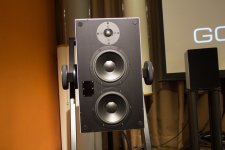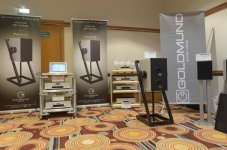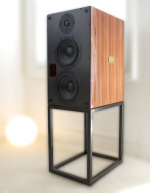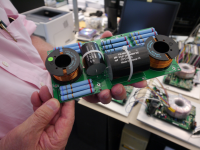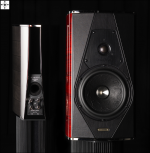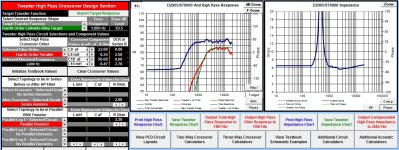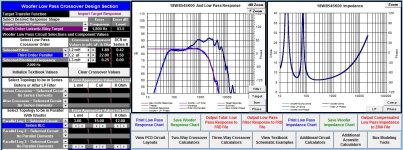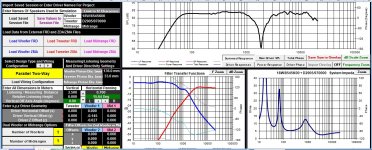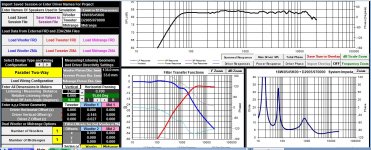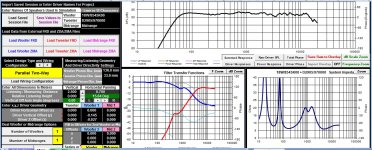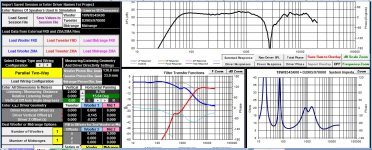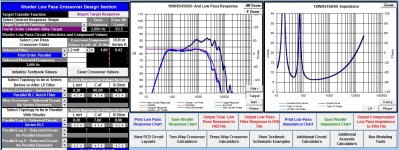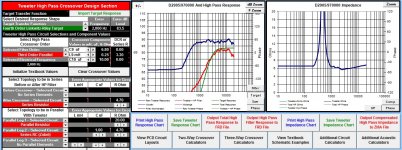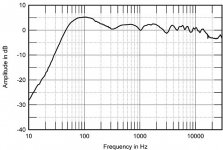This project started because I had a brand new matched pair of the Classic Scan-Speak D2905/970000 tweeters. I wanted to pick a worthy woofer and considered the following:
Audio Technology C-Quenze 18 H 52 17 06 SD - Probably the best 7" midwoofer ever made, but I didn't feel that $500 a piece was justified for this project.
Scan-Speak Revelator 18W/8531G00 - Great on paper, but maybe too lively. Seems like giants such as Sonus Faber and Goldmund have reverted back to using the Classic Scan-Speak product range.
SB Acoustics Satori MW16P - Heard amazing things online, but...
Scan-Speak Classic 18W/8545K00 - This monster has everything going for it and from recent auditions of Sonus Faber's Guarneri Evo, Futura, and Aida, I can say without reservations that the midwoofer is pure magic. Goldmund also uses a Kevlar variant of this midwoofer (8546) in their Epilogue and Logos 1N speakers.
I will be modeling two projects below and would like to get some opinions on which path to take.
The first modeling job will be of the Sonus Faber Guarneri Evolution clone, since I've practically deciphered their entire crossover from pictures. The Guarneri Evo uses a Scan-Speak 18W/8545K00 midwoofers and D2905/970000 tweeters crossed over at 2.8kHz and tuned to Fb of 43Hz.
The second modeling job will be of the Goldmund ProLogos ($38,000!) speakers. They too use the Scan-Speak D2905/970000 tweeters, but supplement them with dual Audio Technology 18H's. I have the official Goldmund crossover for the 970000 tweeters (crossed at 1.8kHz), but will have to model my own filter for the 8545 midwoofers.
Some pictures of the Guarneri Evo's and ProLogos':
Audio Technology C-Quenze 18 H 52 17 06 SD - Probably the best 7" midwoofer ever made, but I didn't feel that $500 a piece was justified for this project.
Scan-Speak Revelator 18W/8531G00 - Great on paper, but maybe too lively. Seems like giants such as Sonus Faber and Goldmund have reverted back to using the Classic Scan-Speak product range.
SB Acoustics Satori MW16P - Heard amazing things online, but...
Scan-Speak Classic 18W/8545K00 - This monster has everything going for it and from recent auditions of Sonus Faber's Guarneri Evo, Futura, and Aida, I can say without reservations that the midwoofer is pure magic. Goldmund also uses a Kevlar variant of this midwoofer (8546) in their Epilogue and Logos 1N speakers.
I will be modeling two projects below and would like to get some opinions on which path to take.
The first modeling job will be of the Sonus Faber Guarneri Evolution clone, since I've practically deciphered their entire crossover from pictures. The Guarneri Evo uses a Scan-Speak 18W/8545K00 midwoofers and D2905/970000 tweeters crossed over at 2.8kHz and tuned to Fb of 43Hz.
The second modeling job will be of the Goldmund ProLogos ($38,000!) speakers. They too use the Scan-Speak D2905/970000 tweeters, but supplement them with dual Audio Technology 18H's. I have the official Goldmund crossover for the 970000 tweeters (crossed at 1.8kHz), but will have to model my own filter for the 8545 midwoofers.
Some pictures of the Guarneri Evo's and ProLogos':
Attachments
Last edited:
Here is the modeling for Goldmund ProLogos clone, using a single Scan-Speak 18W/8545K00 midwoofer instead of dual Audio Technology 18H midwoofers. I'm using the original Goldmund's crossover for the D2905/970000 tweeter and it's as perfect as it gets. Crossed over at 1.8kHz. SPL is +/-1dB from 100Hz - 10kHz and +/-1dB from 100Hz-20kHz at 15 degrees off-axis. This is as good as a 2-way project can get. The drivers are modeled for a 14 liter Dayton pre-built cabinet. Diffraction is modeled using Response Modeler. Crossover is modeled using PCD. I also have access to UniBox and SPL Trace as well as a full blown actual measuring system using calibrated Audix mics and LspCad software.
The crossover here is asymmetrical acoustic 4th order Linkwitz-Riley. Electrically it's a 6th order on the tweeter with an l-pad and a 3rd order on the midwoofer. There's approximately 4dB of baffle step compensation. Fb is tuned to 45Hz in a 14 liter enclosure with a single 2"X7" port. The drivers are not counter sunk for simplicity and the extra diffraction caused has been taken into account.
What do you guys think?
The crossover here is asymmetrical acoustic 4th order Linkwitz-Riley. Electrically it's a 6th order on the tweeter with an l-pad and a 3rd order on the midwoofer. There's approximately 4dB of baffle step compensation. Fb is tuned to 45Hz in a 14 liter enclosure with a single 2"X7" port. The drivers are not counter sunk for simplicity and the extra diffraction caused has been taken into account.
What do you guys think?
Attachments
Last edited:
I can no longer edit my previous reserved post, so here's the Sonus Faber Guarneri Evolution clone:
Sonus Faber crosses the tweeter/midwoofer at 2.8kHz and this proved to be rather difficult with the Scan-Speak 18W/8545. It's a 7" that just doesn't want to be crossed that high. 1.8kHz-2kHz is where it likes to be. The multiple break-ups as well as the cabinet diffraction due to 8.5" width (at around 1kHz) was not easy to deal with. After deciphering Sonus Faber's crossover (topology, not all values are exact) from the picture, I can see why it takes so many parts on the woofer to bend it into shape. It required parallel and series LCR networks for proper shaping.
Having said that, I have listened to the Guarneri Evolution extensively and found no upper midrange problems. It sounded absolutely flawless to me. I'm not sure why Sonus Faber chooses such a high crossover point, but one reason may be to have less energy in the 2kHz-5kHz region. Human ears are extremely sensitive here and any peaking can make a speaker sound terrible, forward, and bright. Sonus Faber also tunes their speakers with a drooping top end. While it doesn't look perfect on paper, the balance sounds fantastic at least to my ear.
The box here is also 14 liter Dayton type, tuned at Fb of 45Hz with a single 2"X7" port.
Diffraction is modeled using Response Modeler. Crossover is modeled using PCD. I also have access to UniBox and SPL Trace as well as a full blown actual measuring system using calibrated Audix mics and LspCad software.
The crossover here is asymmetrical acoustic 4th order Linkwitz-Riley. Electrically it's a 3rd order on the tweeter with an l-pad and Zobel and a series/parallel LCR shaping network on the midwoofer. There's approximately 4dB of baffle step compensation. The drivers are not counter sunk for simplicity and the extra diffraction caused has been taken into account.
Below are some pictures of the modeling as well as actual measurements (for comparison) of the Sonus Faber Guarneri Evolution from Stereophile as well as from Sonus Faber directly.
So which project do you guys like better?
Sonus Faber crosses the tweeter/midwoofer at 2.8kHz and this proved to be rather difficult with the Scan-Speak 18W/8545. It's a 7" that just doesn't want to be crossed that high. 1.8kHz-2kHz is where it likes to be. The multiple break-ups as well as the cabinet diffraction due to 8.5" width (at around 1kHz) was not easy to deal with. After deciphering Sonus Faber's crossover (topology, not all values are exact) from the picture, I can see why it takes so many parts on the woofer to bend it into shape. It required parallel and series LCR networks for proper shaping.
Having said that, I have listened to the Guarneri Evolution extensively and found no upper midrange problems. It sounded absolutely flawless to me. I'm not sure why Sonus Faber chooses such a high crossover point, but one reason may be to have less energy in the 2kHz-5kHz region. Human ears are extremely sensitive here and any peaking can make a speaker sound terrible, forward, and bright. Sonus Faber also tunes their speakers with a drooping top end. While it doesn't look perfect on paper, the balance sounds fantastic at least to my ear.
The box here is also 14 liter Dayton type, tuned at Fb of 45Hz with a single 2"X7" port.
Diffraction is modeled using Response Modeler. Crossover is modeled using PCD. I also have access to UniBox and SPL Trace as well as a full blown actual measuring system using calibrated Audix mics and LspCad software.
The crossover here is asymmetrical acoustic 4th order Linkwitz-Riley. Electrically it's a 3rd order on the tweeter with an l-pad and Zobel and a series/parallel LCR shaping network on the midwoofer. There's approximately 4dB of baffle step compensation. The drivers are not counter sunk for simplicity and the extra diffraction caused has been taken into account.
Below are some pictures of the modeling as well as actual measurements (for comparison) of the Sonus Faber Guarneri Evolution from Stereophile as well as from Sonus Faber directly.
So which project do you guys like better?
Attachments
The crossover here is asymmetrical acoustic 4th order Linkwitz-Riley. Electrically it's a 3rd order on the tweeter with an l-pad and Zobel and a series/parallel LCR shaping network on the midwoofer. There's approximately 4dB of baffle step compensation. The drivers are not counter sunk for simplicity and the extra diffraction caused has been taken into account.
How do you define?
How do you define?
The crossover here is asymmetrical acoustic 4th order Linkwitz-Riley. Electrically it's a 3rd order on the tweeter with an l-pad and Zobel and a series/parallel LCR shaping network on the midwoofer. There's approximately 4dB of baffle step compensation. The drivers are not counter sunk for simplicity and the extra diffraction caused has been taken into account.
How do you define?
I'm not sure I understand your question. If you look at all of the graphs, you'll see traditional acoustic LR4 target slopes and how close I hit them. Electrical slopes are meaningless other than to know what it took to hit the acoustical slopes.
because the graphs for the color white painted about 12 per octave. here's why
an acoustic recession. The type of filter is not visible
an acoustic recession. The type of filter is not visible
Did you ever follow through with this build?
I have the same drivers sitting around and have been thinking about finally assembling them.
I have the same drivers sitting around and have been thinking about finally assembling them.
Not using the K version of the woofer, but I followed the Troels now removed design of the Amish 45/97: Amish 45/97 Construction Diary
- Home
- Loudspeakers
- Multi-Way
- Scan-Speak 18W/8545K00 and D2905/970000 2-Way Project
